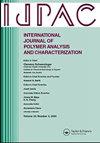Extraction, characterization, and evaluation of galactomannan from Barbatimão Verdadeiro as a potential additive for enhanced oil recovery fluids
IF 1.7
4区 工程技术
Q4 POLYMER SCIENCE
International Journal of Polymer Analysis and Characterization
Pub Date : 2025-01-02
DOI:10.1080/1023666X.2024.2421817
引用次数: 0
Abstract
Polymers play a crucial role in enhanced oil recovery (EOR) by increasing the viscosity of injection fluids and enhancing oil displacement. The widely used polymer, partially hydrolyzed polyacrylamide (HPAM), faces performance degradation in high-salinity and high-temperature environments. This study explores galactomannan from Stryphnodendron polyphyllum seeds as an alternative viscosifying agent for EOR fluids. An extraction process for galactomannan from Barbatimão Verdadeiro seeds was developed, yielding 23.3% m/m. The biopolymer was characterized using Fourier transform infrared spectroscopy (FTIR), nuclear magnetic resonance (NMR), thermogravimetric analysis (TGA), and size exclusion chromatography (SEC). Rheological behavior was tested in brines of different salinities, and injectivity/filterability tests were performed following API RP 63:1990 standards. The galactomannan obtained from Stryphnodendron polyphyllum exhibited a mannose-to-galactose ratio of 1.32. Rheological analysis showed pseudoplastic behavior, with viscosities of 38 cP in brine solutions at 7.37 s−1 and 60 °C. Filterability tests demonstrated satisfactory injectivity with factors of 1.09 (8 µm) and 0.67 (1.2 µm). Compared to HPAM, galactomannan exhibited superior viscosity retention in high-salinity conditions, where HPAM dropped to 6 cP. The galactomannan extracted from Stryphnodendron polyphyllum seeds is a promising biopolymer for EOR applications, offering superior performance under harsh conditions compared to traditional HPAM. Its resilience to high salinity and temperature makes it a viable alternative for pre-salt and offshore fields, contributing to more sustainable and efficient oil recovery.
barbaratim o Verdadeiro中半乳甘露聚糖作为一种潜在的提高采收率的添加剂的提取、表征和评价
聚合物通过增加注入液的粘度和提高驱油量,在提高采收率(EOR)方面发挥着至关重要的作用。部分水解聚丙烯酰胺(HPAM)是一种广泛应用的聚合物,在高盐度和高温环境中存在性能退化问题。本研究探讨了半乳甘露聚糖作为提高采收率液体的一种替代增粘剂。开发了从baratim o Verdadeiro种子中提取半乳甘露聚糖的工艺,产量为23.3% m/m。采用傅里叶变换红外光谱(FTIR)、核磁共振(NMR)、热重分析(TGA)和粒径排除色谱(SEC)对该生物聚合物进行了表征。在不同盐度的盐水中测试了流变行为,并按照API RP 63:1990标准进行了注入性/滤过性测试。从毛茛中提取的半乳甘露聚糖甘露糖与半乳糖的比值为1.32。流变学分析显示出假塑性行为,在7.37 s−1和60°C的盐水溶液中粘度为38 cP。滤过性测试表明,注入率为1.09(8µm)和0.67(1.2µm),令人满意。与HPAM相比,半乳甘露聚糖在高盐度条件下表现出更好的粘度保持,HPAM降至6 cP。从毛茛种子中提取的半乳甘露聚糖是一种很有前途的EOR生物聚合物,与传统的HPAM相比,它在恶劣条件下具有优越的性能。它对高盐度和高温度的适应性使其成为盐下油田和海上油田的可行替代方案,有助于实现更可持续、更高效的采油。
本文章由计算机程序翻译,如有差异,请以英文原文为准。
求助全文
约1分钟内获得全文
求助全文
来源期刊
CiteScore
3.50
自引率
5.30%
发文量
37
审稿时长
1.6 months
期刊介绍:
The scope of the journal is to publish original contributions and reviews on studies, methodologies, instrumentation, and applications involving the analysis and characterization of polymers and polymeric-based materials, including synthetic polymers, blends, composites, fibers, coatings, supramolecular structures, polysaccharides, and biopolymers. The Journal will accept papers and review articles on the following topics and research areas involving fundamental and applied studies of polymer analysis and characterization:
Characterization and analysis of new and existing polymers and polymeric-based materials.
Design and evaluation of analytical instrumentation and physical testing equipment.
Determination of molecular weight, size, conformation, branching, cross-linking, chemical structure, and sequence distribution.
Using separation, spectroscopic, and scattering techniques.
Surface characterization of polymeric materials.
Measurement of solution and bulk properties and behavior of polymers.
Studies involving structure-property-processing relationships, and polymer aging.
Analysis of oligomeric materials.
Analysis of polymer additives and decomposition products.

 求助内容:
求助内容: 应助结果提醒方式:
应助结果提醒方式:


